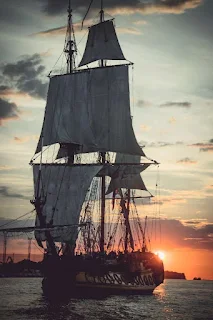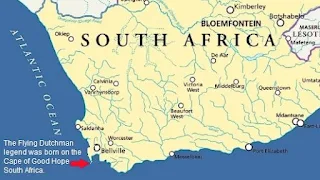South African Flying Dutchman Legend
The Flying Dutchman legend was born in South Africa.
Fear of Dutch sea captains, Cape of Good Hope deadly currents and weather, seamen superstitions help to spread the fear of the flying Dutchman.
Before Spongebob Squarepants met the Flying Dutchman, in South Africa in 1689 on the Cape of Good Hope the legend of the Flying Dutchman began.
The Flying Dutchman is a legendary ghost ship that is said to be cursed to sail the seas forever without ever being able to make port.
The sea is its own kingdom full of supernatural beings, The Flying Dutchman legend was told and retold in South Africa and supernatural appearances are never explained away.
 |
| The Flying Dutchman |
The competition between sea captains to make money from Africa’s trade routes, spices, slaves, and gold was intense.
Beginning in the late 15th century until the 17th century, around 1595 to 1830, the Dutch shipped an estimated 500 million enslaved Africans from The Dutch Slave Coast, Slavenkust the present-day African country of Ghana.
The spices we take for granted today as we scroll though the grocery store were once scarce and extremely valuable.
The Dutch control over the clove, pepper and nutmeg spice trade though The Dutch East India Company broke the stranglehold on the spice trade.
English, Portuguese and Spanish spice traders were terrified of the Dutch sea captains.
For example, in 1601 a fleet of five Dutch ships drove away a fleet of thirty Portuguese ships from a long established Portuguese trading route.
The South African Dutch Sea Captain The Flying Dutchman Legend Begins.
Superstitions are powerful among people who sail the seven seas. The sea is its own kingdom full of supernatural beings. The Portuguese called the African Cape of Good Hope the Cape of Torment.
Portuguese explorer Bartolomeu Dias was the first to successfully reach the southernmost tip of Africa in 1488 and named it the Cape of Good Hope.
Many ships attempted to sail the trading route but failed and died in the attempt. Meeting place of two violent currents, savage winds, warring storms, dramatic rock formations, and ships disappearing without a trace have made the Cape of Good Hope one of the world's largest ship graveyards to the present day.
In May 1822, there were 18 ships destroyed by storms or lost without a trace and attributed to the legendary Flying Dutchman.
Coupled with the fear of Dutch sea captains, the treacherous weather conditions of the Cape of Good Hope and the superstitious nature of seamen, The Flying Dutchman legend persists.
As legend has it the Dutch thought themselves superior to all seaman and instead of waiting for an infamous Cape of Good Hope storm to pass, a Dutch sea captain made a statement in a tavern putting his sailing skills above any storm mother nature and God would throw at him stating ”I will be successful in this trip despite what God brings to me, I will land this trip in the name of God or the devil, whichever one gets me there!”
 |
| The Flying Dutchman |
The captain therefore set sail into the Cape of Good Hope but his ship was never seen again. His ship is said to be the ghost ship The Flying Dutchman doomed to sail the seas forever never to make port because he defied God.
The Flying Dutchman is a reminder to all seafarers that they must respect nature. Everything on the ocean is small and you do not place yourself above God as the Flying Dutchman did in 1689, you should always fear and respect the sea. Any seafarer who sets eyes on the Flying Dutchman ship is an ominous omen of their pending death.
Royal Navy officer Captain Frederick Marryat is quoted as saying “Seamen, since the beginning of time, have been a race unto themselves, having their own mode of life, customs and beliefs.
They believe in lucky and unlucky days, signs, clouds, birds, and breezes... Above all they believe in an Evil Spirit of the sea, who delights to bring harm to mariners, send adverse winds and waves, and drag them down into the depths of the ocean.
This Spirit, they say, can change a gentle breeze to a terrific gale in an instant. He can cause vessels to sink that have no leak. He can set strange lights ahead and thus lure a crew to dangerous reefs.”
 |
| Cape of Good Hope South Africa |
Flying Dutchman Can't Catch Me Game
Popular Flying Dutchman game that requires no supplies and only imagination. It's suitable for elementary-age kids.
Objective: Be the last player standing without getting caught by the Flying Dutchman.
Instructions:
Designate one player as the Flying Dutchman.
All other players will scatter and spread out in the designated play area.
The Flying Dutchman's goal is to tag or catch the other players.
Once a player is caught by the Flying Dutchman, they join forces and become crew members of the Flying Dutchman.
The Flying Dutchman and the crew members should hold hands to form a line or chain.
The Flying Dutchman and the crew members can only move by hopping or taking small steps.
The Flying Dutchman and the crew members work together to catch the remaining players.
The players who have yet to be caught must try to avoid getting tagged by the Flying Dutchman and the crew members.
Players can move freely and use their imagination to dodge, hide, or outrun the Flying Dutchman and the crew members.
The game continues until all players have been caught by the Flying Dutchman and become crew members or until only one player hasn't been caught.
The last remaining player who hasn't been caught becomes the Flying Dutchman for the next round.
The Flying Dutchman is a legend in the Arts, Sports and Games.
The 1833 MS. Found in a bottle, a short story by Edgar Allan Poe printed in the Baltimore Saturday Visiter is a story about the flying dutchman legend and the supernatural horrors at sea.
The first written account of the Flying Dutchman legend in novel form was penned in 1838 in The New Monthly Magazine under the title of The Phantom Ship by the English Captain Frederick Marryat.
The most famous account of the Netherlands Flying Dutchman is the 1843 opera Der Fliegende Holländer, The Flying Dutchman. This famous opera is still being performed today and is credited for introducing The Flying Dutchman to mainstream audiences and keeping the supernatural story alive.
More links to articles you will find thought provoking.
- Dangerous Erupting Volcanoes of Africa

- Top 20 Largest Countries in Africa

-
What is an African Proverb

- African Water Spirit Mami Wata

-
Ancestors are Guardian Angels







